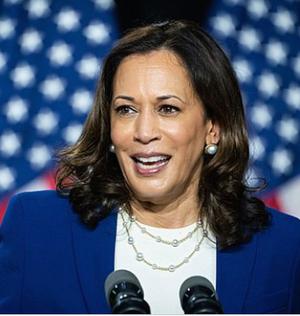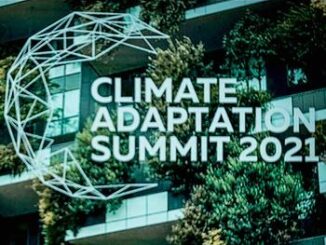
WASHINGTON, DC, October 8, 2024 (ENS) – This year, for the first time, the climate crisis is appearing in political discussions, and occasionally on polls and in fundraising appeals.
As the two candidates contesting the 2024 U.S. presidential election met for the first time on the ABC-TV debate stage in Philadelphia on September 10, the viewing public began to realize that
Vice President Kamala Harris for the Democrats and former President Donald Trump for the Republicans couldn’t be farther apart on climate.
The ABC moderators saved the climate questions for last, giving each candidate one minute to answer.
“We have another issue that we’d like to get to that’s important for a number of Americans, in particular younger voters, and that’s climate change,” moderator Linsey Davis said. “President Trump, with regard to the environment, you say that we have to have clean air and clean water.”
“Vice President Harris, you call climate change an existential threat. The question to you both tonight is what would you do to fight climate change? And Vice President Harris, we’ll start with you.”
“Well, the former president had said that climate change is a hoax,” Harris said. “And what we know is that it is very real.”
“You ask anyone who lives in a state who has experienced these extreme weather occurrences who now is either being denied home insurance or is being jacked up. You ask anybody who has been the victim of what that means in terms of losing their home, having nowhere to go,” Harris said.

“We know that we can actually deal with this issue. The young people of America care deeply about this issue. And I am proud that as vice president over the last four years, we have invested a trillion dollars in a clean energy economy while we have also increased domestic gas production to historic levels,” Harris said. “We have invested in clean energy to the point that we are opening up factories around the world.”
“I’m also proud to have the endorsement of the United Auto Workers and Shawn Fain, who also knows that part of building a clean energy economy includes investing in American-made products, American automobiles. It includes growing what we can do around American manufacturing and opening up auto plants, not closing them like what happened under Donald Trump,” the vice president said.
As Trump responded, he denied that plants were closed during his term in the White House, 2017-2021, and took off on manufacturing jobs, not climate.
As President, Trump rolled back over 100 environmental rules and regulations, opening up 18.6 million acres of Alaska’s Arctic National Wildlife Refuge for fossil fuel exploration and canceling a requirement that fossil fuel companies report their methane emissions.
Oil production increased during Trump’s term as president. It continued to increase during the Biden-Harris Administration and is now at an all-time high.
Under the Biden Administration, 1,453 new licenses on oil and gas were approved – 20 percent more than under the Trump Administration.
In 2021, a federal judge disallowed a Biden executive order to stop all new oil and gas drilling on public lands and in public waters.
The Biden-Harris Administration’s work to build resilience and mitigate climate change is outlined in a Fact Sheet from the White House issued on September 23.
“When President Biden took office,” the Fact Sheet states, “he pledged to restore America’s climate leadership at home and abroad. Every day since, the Biden-Harris Administration has led and delivered on the most ambitious climate, conservation, clean energy, and environmental justice agenda in history, including securing the largest ever climate investment and unleashing a clean energy manufacturing boom that has attracted hundreds of billions of dollars in private sector investment; created hundreds of thousands of new clean energy jobs; and lowered energy costs for families while delivering cleaner air and water for communities across the country.”
President Biden addressed the business leaders, government officials, young people, and other advocates from around the world gathered in New York City for Climate Week, September 22-29, on how his administration has strengthened America’s clean energy activities.
During the Biden-Harris Administration, begun in January 2021, the United States has added more than 100 gigawatts of new clean energy – enough to power more than 25 million homes.
Through the Inflation Reduction Act and Bipartisan Infrastructure Law, President Biden made the largest investment ever in a clean power sector, unleashing a boom in American solar, wind, battery storage, and other clean energy technologies. Biden and his administration count nuclear power as a “clean” energy technology although nuclear waste disposal is an issue that is still not settled.
Under the Inflation Reduction Act, clean energy project developers get access to expanded tax incentives if they pay workers prevailing wages and employ registered apprentices, build their projects with domestic content, or locate projects in historic energy communities.
Last year, the Biden-Harris Administration released the National Blueprint for Transportation Decarbonization, a strategy for eliminating nearly all greenhouse gas emissions from the U.S. transportation sector by 2050.
The Administration’s Bipartisan Infrastructure Law and Inflation Reduction Act invest tens of billions to decarbonize maritime, trucking, transit, rail, and aviation, while making communities more walkable, bikeable, and connected. The same law is also investing $7.5 billion to build a nationwide network of convenient, reliable electric vehicle charging infrastructure along corridors and within communities, and $5 billion to put clean school buses on U.S. roads. In addition, Biden has rallied automakers and autoworkers around a historic goal of having electric vehicles account for at least 50 percent of new passenger vehicles sold by 2030.
To help young people access skills-based training for good-paying careers in the clean energy and climate resilience economy, the Biden-Harris Administration launched the American Climate Corps, which will mobilize a new, diverse generation of more than 20,000 Americans.
“With direct support from the Administration’s Investing in America Agenda, more than 45 states and more than 200 Tribes, territories, and metro areas have now developed their own Climate Action Plans. All of these foundational efforts will support climate solutions in the near-term and for years to come, helping the nation achieve the goal of reducing climate pollution by 50-52% below 2005 levels in 2030 and reaching a net-zero economy by no later than 2050,” the white House said.
To read the entire array of Biden-Harris climate actions, click on the White House Briefing Room here.
Brookings Analyzes Trump
Fuel economy standards for cars and light trucks were set back under President Trump; we see the results today – transportation is the greatest source of U.S. greenhouse gas emissions.

As President, Trump took 74 actions to weaken environmental protection, according to the Brookings Institution, a nonprofit research organization based in Washington, DC that issued an August 2020 report on the Trump Administration’s environmental track record.
Trump was focused on ridding his administration of existing policies that addressed climate change, which was possible because Congress had been unwilling to enshrine such policy in law, Brookings said in its report.
Author Samantha Gross is director of the Energy Security and Climate Initiative at The Brookings Institution, and the former director for International Climate and Clean Energy at the Office of International Affairs at the U.S. Department of Energy.
Trump’s ability to roll back climate rules stems from actions of the Obama Administration, which used existing law and executive orders to regulate greenhouse gas emissions because Congress was unwilling to act, Gross explained.
In 2007, the U.S. Supreme Court found that greenhouse gases are within the Clean Air Act’s definition of an air pollutant, and so they can be regulated as a pollutant. As President, Barack Obama used the Clean Air Act to establish the Clean Power Plan, key to his strategy to reduce climate-warming emissions.
But when Trump came into office in 2016, he replaced Obama’s Clean Power Plan with a weaker regulation and eliminated other regulations governing climate-warming emissions.
Since the greenhouse gas carbon dioxide (CO2) is considered a pollutant under the Clean Air Act, the Trump Administration had to provide a replacement for the Clean Power Plan.
Yet the Environmental Protection Agency warned that Trump’s Affordable Clean Energy Rule would have resulted in only a one percent reduction in greenhouse gas emissions from power plants, compared to no policy.
Brett Hartl, political director, Center for Biological Diversity Action Fund, called Trump’s attitude about climate “obscene.”
“It’s obscene that communities… are suffering and dying from the reality of the climate emergency while Donald Trump denies that it even exists,” he said.
Trump’s current proposals, such as weakening the Federal Emergency Management Agency and the National Oceanic and Atmospheric Administration, would leave communities vulnerable to extreme weather events that result from the heating of the oceans and the atmosphere.
A coalition of climate-focused groups has launched a $55 million ad campaign focused on the economic benefits of Harris’s environmental policies ahead of the 2024 presidential vote.
The ad campaign, targeting six swing states, emphasizes that Harris’s climate policies can bring the country an economic boost. Both President Biden and Vice President Harris have always linked the clean energy policies of their administration with increased manufacturing jobs and economic growth.
“Clean energy is cheaper energy,” Pete Maysmith, senior vice president of campaigns at the League of Conservation Voters, told the New York Times. “If she’s looking at how can things be more affordable for voters, this is one way to do that.”
Others also worry about what the former president would do if he is re-elected.
Medical doctor Beth Zigmund published today in MedPage an article entitled, “The Project 2025 Promise: Worse Health and Climate Chaos.” An associate professor of clinical radiology at the Larner College of Medicine at the University of Vermont Medical Center, Dr. Zigmund also serves on the Steering Committee of the Medical Society Consortium on Climate and Health.
“Climate change increasingly threatens health and financial well-being. Nearly 8 million acres in the U.S. have burned so far in 2024 in another season of historic fires; many Northeasterners and Midwesterners reel from yet another season of disastrous floods; Hurricane Helene left hundreds dead and caused yet untold wreckage and human suffering in its wake,” she writes.
And now Milton threatens Florida as a Category 5 Hurricane less than two weeks after Hurricane Helene left a wide swath of ruin across Florida and the Southeast.
“This is not normal,” Dr. Zigmund writes. “Billion-dollar weather disasters multiply year over year, straining local, state, and federal budgets; costs over the coming decades will be determined by current climate mitigation and adaptation measures. Health insurance rates could rise in regions exposed to climate risks. The world is at a critical juncture where we must rapidly phase out fossil fuel use to avoid catastrophic climate tipping points.”
Featured image: Wildfire smoke in Western Montana at sunset, WMO 2024 Calendar Competition (Photo by Jonathan Kamensky courtesy World Meteorological Organization)
© 2024, Environment News Service. All rights reserved. Content may be quoted only with proper attribution and a direct link to the original article. Full reproduction is prohibited.



